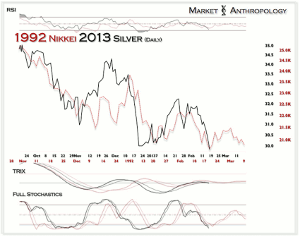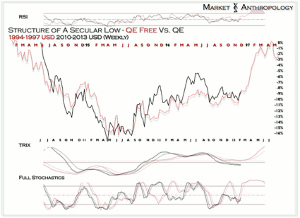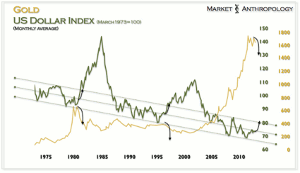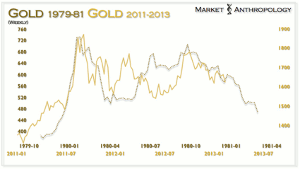In recent weeks, gold and silver have been either falling or range-bound, and Erik Swarts of MarketAnthropology.com offers his theory on why.
Back in late June of last year I adapted the comparative with silver from the
Nasdaq top in 2000, to the prequel asset bubble of the late 1980's-the Japanese
Nikkei market (explained here). And although the Fed subsequently intervened with
additional quantitative measures in September and once again in December, silver
has continued to follow the momentum drain and profile of the Nikkei market-some
seven months later.
It has been my standing belief that when the US dollar bottomed in 2011, and despite the historic
quantitative measures undertaken by the Fed-the precious metals, and
peripherally the commodity markets-were now large asset bubbles on the backside
of the cycle. It is why I have referred to the US dollar low comparative as "QE
Free vs. QE," because I wanted to make the not-so-subtle point that regardless
of the Fed's hand, the US dollar was still carving out a secular low-very much
along the lines of its last.
Backing away from the more efficient market construct with the belief it is an imperfect calculus as to why any asset-let alone a currency, settles at an arbitrary price; I would argue the weight of causation tends to favor perception and the underlying market psychology of said asset-rather than the structural underpinnings themselves.
I would argue this neatly explains the US dollar as the primary motivator of
gold and silver and the historic commodity cycle over the past
decade. They became-for all intents and purposes, massively overvalued currency
hedges of the US dollar. Undoubtedly, there have been various supporting,
propelling, and governing measures for each respective asset along the way, but
the US dollar-the world's dominant reserve currency-was the catalyst for concern
with setting those fires ablaze in 2002, and the catalyst that is now
extinguishing them as it pivots out of an intermediate-term low and away from
another secular low.
Hysterical capitalists don't fret, there's plenty to be concerned with that will surely light the next asset fire in the capital markets. However, the end of US dollar hegemony does not appear to be one of them right now.
Erik Swarts can be found at MarketAnthropology.com.






















